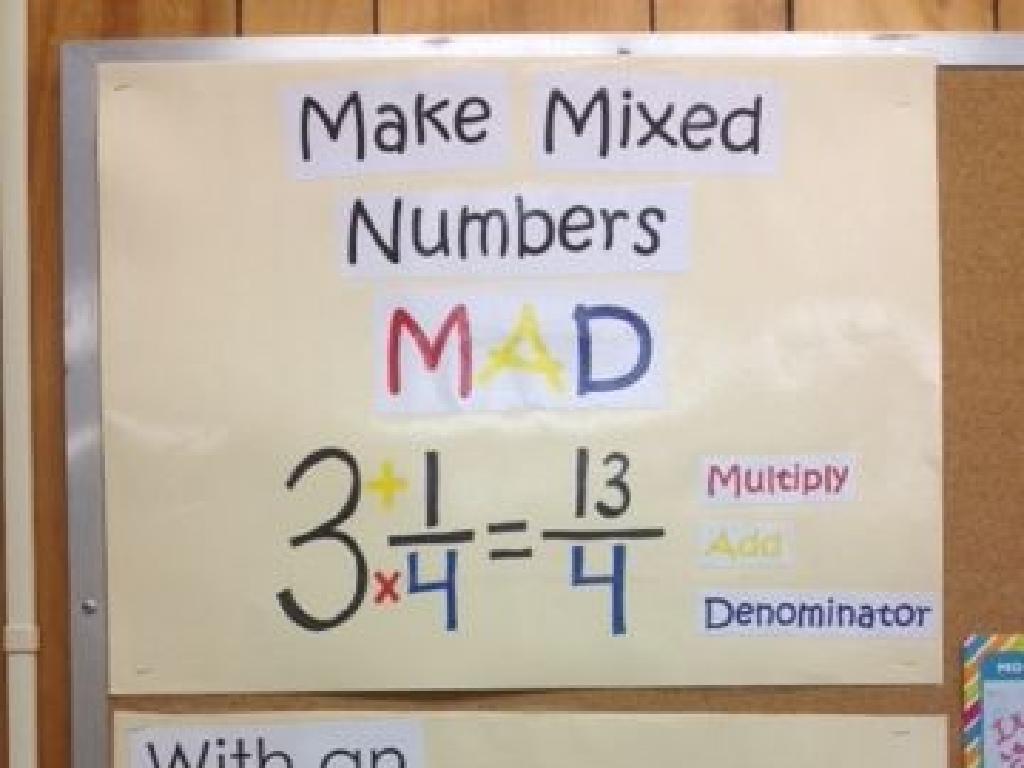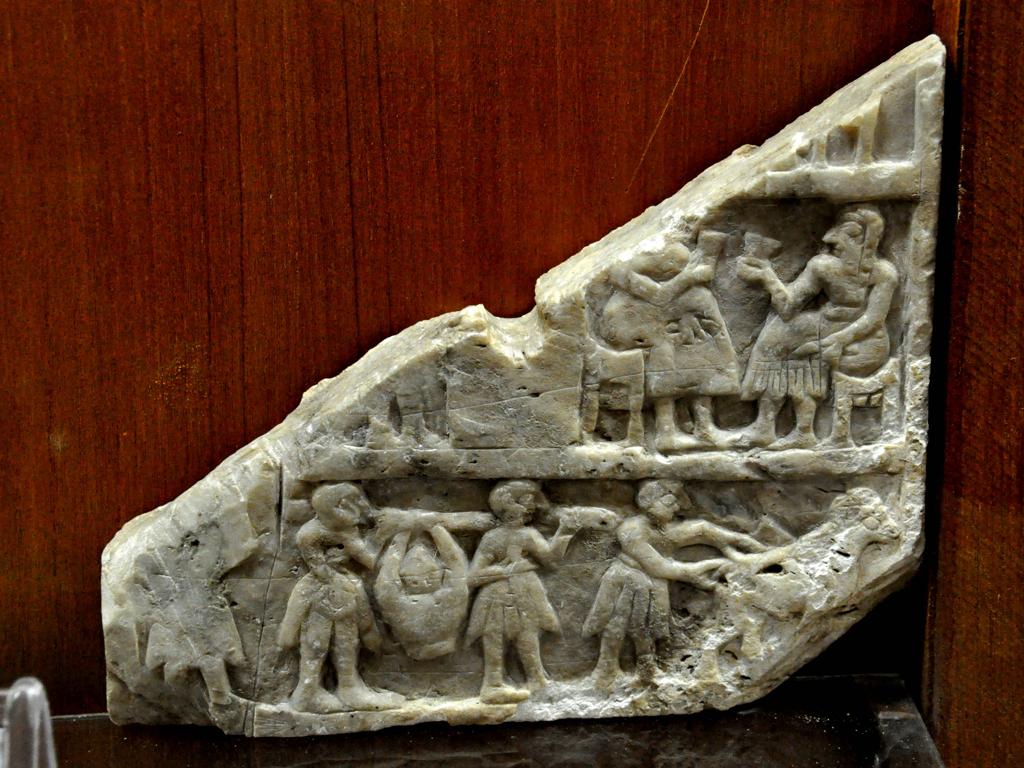Divide Fractions And Mixed Numbers: Word Problems
Subject: Math
Grade: Seventh grade
Topic: Operations With Fractions
Please LOG IN to download the presentation. Access is available to registered users only.
View More Content
Dividing Fractions: Introduction & Applications
– Understanding fractions & division
– A fraction represents a part of a whole, and division is sharing equally.
– Importance of dividing fractions
– Mastering this skill is crucial for advanced math concepts.
– Real-life fraction division examples
– Cooking or dividing a pizza into equal parts are practical uses.
– Practice with word problems
|
This slide introduces the concept of dividing fractions, which is a fundamental skill in mathematics. Begin by explaining what fractions are and how division is essentially the process of dividing something into equal parts. Emphasize the importance of learning to divide fractions as it is not only a key skill for higher-level math but also for solving everyday problems. Provide real-life examples such as adjusting a recipe when cooking or dividing a pizza among friends to make the concept relatable. Conclude by encouraging students to apply this knowledge to word problems, which will be practiced in class to reinforce their understanding.
Review of Fractions: Understanding the Basics
– Recap: Fractions representation
– Fractions show parts of a whole, like slices of a pizza
– Numerator vs. Denominator
– Top number (numerator) and bottom number (denominator) roles
– Simple fractions examples
– 1/2 of an apple, 3/4 of a water jug
– Visualizing fractions
– Drawings or objects to represent fractions help in understanding
|
Begin the lesson by recapping what fractions represent, emphasizing that they are a way to express parts of a whole. Clarify the roles of the numerator and denominator, with the numerator indicating how many parts we have and the denominator showing the total number of equal parts in the whole. Provide simple, relatable examples such as cutting an apple into halves or filling a water jug to three-quarters. Use visual aids like pie charts or fraction strips to help students visualize fractions, which is crucial for their understanding before moving on to more complex operations like dividing fractions and mixed numbers.
Understanding Division of Fractions
– What division represents
– Division means splitting into equal parts or groups.
– Division as sharing/grouping
– Imagine dividing a pizza among friends or grouping objects.
– Work through simple examples
– Example: 12 ÷ 4 = 3 means 12 items shared by 4 people.
– Apply division to fractions
– How to divide a whole number by a fraction and vice versa.
|
This slide is a review of the basic concept of division before applying it to fractions. Start by discussing what division means in terms of splitting something into equal parts or groups. Use relatable examples like sharing food or grouping items to illustrate the concept. Provide simple division examples to ensure students are comfortable with the operation. Then, transition to applying division to fractions, explaining how dividing by a fraction is the same as multiplying by its reciprocal. Encourage students to think of real-world scenarios where they might need to divide objects or quantities into fractions or mixed numbers. This will set the foundation for solving word problems involving the division of fractions and mixed numbers.
Dividing Fractions – The Rule
– To divide fractions: Invert and Multiply
– Invert the second fraction before multiplying
– Flip the second fraction’s numerator and denominator
– Step-by-step example problem
– 1/2 ÷ 3/4 becomes 1/2 x 4/3. Multiply across to get 4/6, which simplifies to 2/3
– Practice problem for understanding
– Solve 2/5 ÷ 7/10 and share your steps
|
When teaching students to divide fractions, start by explaining the ‘invert and multiply’ rule. Emphasize the importance of inverting only the second fraction. Provide a clear example, such as dividing 1/2 by 3/4, and show step-by-step how to invert the second fraction and multiply to find the answer. After the example, give students a practice problem like 2/5 ÷ 7/10 to solve on their own, ensuring they apply the steps correctly. This exercise will help solidify their understanding of the concept. Encourage students to simplify their answers whenever possible to practice finding the greatest common factor.
Dividing Mixed Numbers
– Convert mixed to improper fractions
– Multiply the whole number by the denominator, add the numerator
– Divide the improper fractions
– Invert the divisor and multiply across
– Convert result to mixed number
– Divide the numerator by the denominator for the whole number
– Simplify your answer
– Ensure the fraction is in its simplest form
|
This slide is aimed at teaching students the process of dividing mixed numbers by first converting them into improper fractions. Start by multiplying the whole number part of the mixed number by the denominator and then adding the numerator to get an improper fraction. Next, students will learn to divide improper fractions by inverting the divisor and multiplying. After obtaining the result, they will convert it back into a mixed number by dividing the numerator by the denominator to find the whole number, and the remainder becomes the new numerator. Lastly, students should simplify their answer to ensure it is in the lowest terms. Provide examples for each step and encourage students to practice with problems of varying difficulty.
Dividing Fractions: Word Problems
– Comprehend the word problem
– Read carefully to grasp the scenario.
– Spot the fractions involved
– Look for and highlight the fractional numbers.
– Execute division to find solution
– Use the ‘invert and multiply’ method to divide.
– Check your answer’s reasonableness
– Does the answer make sense in the context?
|
This slide is aimed at guiding students through the process of solving word problems that involve the division of fractions. Start by ensuring they understand the context and what the problem is asking. Then, have them identify all the fractions that are part of the problem. Teach them to apply the ‘invert and multiply’ technique to divide these fractions. After solving, students should be encouraged to think critically about their answer by checking if it makes sense within the context of the problem. For example, if dividing a quantity of food among people, does the amount each person gets seem reasonable? This step is crucial for developing problem-solving skills and ensuring accuracy.
Dividing Fractions: Word Problem
– Read the problem together
– Break down into steps
– Identify keywords and what’s being asked
– Solve the problem step-by-step
– Apply division of fractions to find the answer
– Discuss the solution
– Review the steps and answer to ensure understanding
|
This slide is designed for a collaborative class activity focused on solving a word problem involving the division of fractions and mixed numbers. Start by reading the problem aloud with the class to ensure understanding. Next, guide students to break down the problem into manageable steps, identifying keywords and what the problem is asking them to find. Work through the problem step-by-step as a class, applying the rules for dividing fractions. After solving, discuss the solution to reinforce the concept and address any misunderstandings. Encourage students to ask questions and explain their thought process. Possible activities include having students write their own word problems, peer teaching, or creating a visual representation of the problem.
Fraction Division: Practice Problems
– Solve Individual Problem 1
– Use division to solve: 3/4 ÷ 2/3
– Tackle Individual Problem 2
– Find the quotient: 5 1/2 ÷ 1 3/4
– Collaborate on Group Problem
– Work together: 2 2/3 ÷ 1 1/5
– Review and Discuss Answers
|
This slide is dedicated to practicing the division of fractions and mixed numbers through word problems. For Individual Problem 1, students will apply their knowledge to divide simple fractions. Problem 2 increases in complexity by involving mixed numbers. The Group Practice Problem is designed to foster collaborative problem-solving skills and encourage peer learning. After completing the problems, there will be a review session to discuss the answers and clarify any misunderstandings. Ensure that students show their work step by step and check their answers by multiplying the quotient by the divisor to see if they get the dividend. This will reinforce their understanding of the inverse relationship between multiplication and division.
Class Activity – Fraction Division Relay
– Divide class into competitive teams
– Each team tackles a unique problem
– Use word problems involving dividing fractions and mixed numbers
– Present solutions and methods
– Explain how you solved the problem step by step
– Discuss different strategies used
– Compare various approaches to the same problem
|
This activity is designed to promote teamwork and enhance students’ understanding of dividing fractions and mixed numbers through practical application. Start by dividing the class into small groups, ensuring a mix of abilities in each team. Provide each team with a different word problem that requires them to divide fractions or mixed numbers. After solving the problems, each team will present their solution and the strategy they used to the class. Encourage teams to explain their thought process clearly. This will help students learn from each other and understand that there can be multiple ways to approach a problem. Possible activities could include real-life scenarios such as dividing a recipe into portions or splitting a number of items evenly among a group. The goal is to foster a collaborative learning environment where students can discuss and learn different methods of solving fraction division problems.
Wrapping Up: Division of Fractions
– Recap of fraction division
– Reviewed how to divide fractions and mixed numbers using word problems.
– Practice makes perfect
– Consistent practice is crucial for mastering these concepts.
– Open floor for questions
– It’s important to ask questions if you’re unsure about the material.
– Encourage ongoing learning
– Keep practicing at home with additional problems.
|
As we conclude today’s lesson on dividing fractions and mixed numbers through word problems, it’s essential to summarize the key concepts to reinforce learning. Remind students that understanding these operations is fundamental in math and will be used in future topics. Emphasize the importance of practice, as it is through repetition that they will become more comfortable with these types of problems. Open the floor for any questions or clarifications to ensure that all students are leaving the class with a clear understanding of the material. Encourage them to continue practicing at home and to seek help if they encounter difficulties. Provide additional resources or worksheets for further practice.






